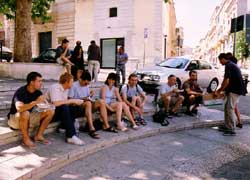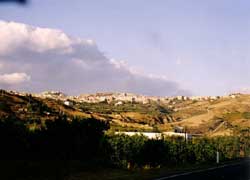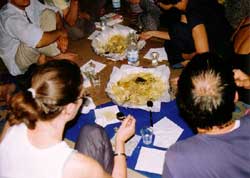Networking Europe - Report on Oreste 3 by Sophie Hope
Practically speaking, Oreste is a network of Italian artists who meet to discuss projects and ideas. They organise annual 'conferences' in Italy which aim to support a collective dialogue stemming from the artists' individual practices. The group was set up in reaction to the lack of support artists felt they were receiving from the Italian government - public money is often directed at the country's heritage rather than towards the developing practice of young artists. Oreste is not easily defined, however. As we discovered, it can be what you want it to be and what you make of it. That the group shares the same name as the Greek trilogy and tragedy Orestes suggests it brings to life a tangled web of characters.
The idea for the residency programme this year was to invite artists from all over Europe to Montescaglioso, a town on the sole of Italy, to see what would happen. As Oreste received an EU grant that supports youth initiatives and collaborations across the European countries, travel, accommodation and food expenses were all covered for the visiting artists. There were groups from Finland, Holland, Poland, Hungary and Britain as well as artists from New York, Switzerland and of course, Italy.
The group from Britain consisted of six individual artists/curators: Sarah Carrington, Martin Clarke, Neil Harman, Douglas MacFarlane, Rupert Norfolk and myself. We had not worked together before, but our paths had crossed at various times and situations in London (echoing the growing web of coincidences of the Greek tragedy). The original group consisted of artists involved in the collective Arthur R Rose and this was the first strand of the expanding web. This was an opportunity to get to know each other just as much as the groups from the other countries.
Two structured projects took place over the two weeks - Fifteen Dinners and A Sense of Home. The dinners were coordinated by members of Oreste and visiting artists. Some were themed or nationalistic. For example, there was an Islamic feast in the refectory of the monastery in Montescaglioso where the last people to eat were the monks, over two hundred years ago. The dinner involved making a carpet from cardboard and spray paint and then sitting cross-legged, eating couscous and potatoes with our hands. Another dinner, organised by the Finnish group, involved walking a few miles from the town, across the fields in the dark to a farmhouse where we ate a meal prepared by the Finns and Italians. The combination of menus were served in the courtyard of this old building. There were video projections and slide shows of the Finns in the sauna they had constructed on the beach a few days earlier, and images from our walk to the dinner. A Sense of Home was organised to build relationships between visiting artists and local people. The town is not a tourist spot and the problems of parachuting a large group of foreigners into a small unsuspecting town are obvious. The events - dinners and discussions - often seemed inviting to the locals. It was interesting to find out how the different generations lived in such a remote part of Italy.
The emphasis was very much on meeting people and making contacts. The dinners and discussion became the art experience. These experiences were documented and explored in the collaborative 'daily' DOPO - a newspaper made and distributed during the residency by the Dutch group. We had displays of our work and current activities in London. This provoked informal discussions triggered by the visual material. Links were made between groups and experiences were shared. The Polish group, for example, reconstructed their local club with lighting, food, music and lots of tinfoil and vodka!
The groups and individuals we met will hopefully lead to interesting future exchanges. The whole experience made me more aware of how many links we have to other European contexts through our artistic and curatorial practices, and Oreste 3 was a starting point for developing and exploring them.
CONTACTS
Italy:
- Undo (Anna Stewart and Vincenzo Chiaranda) E: staff@undo.net www.undo.net - Website with listings and reviews of projects by Italian artists. They welcome international listings.
- Care Of (Mario Gorni and Zefferina Castoldi), Via Zucchi 39G, Cusano Milanino 20095, Italy E: careof@tin.it - Based in Milan this organisation is currently developing a growing network of artists and curators to support an international residency-exchange programme. They also house an archive of contemporary video works.
Finland:
- Residency Programme in Nykarlby, organised by Albert Braun. E: albertbraun@syh.fi - Supports international artists and is located in the art school. They welcome individual artists to apply.
The Netherlands:
- Room (Karin De Jong and Ewoud van Rijn), Vievambachtsstr 17 BII, 3022 AB Rotterdam, The Netherlands E: roombase@luna.nl - Artist-run space in Rotterdam that often changes location throughout the city. Projects are developed by young local and international artists.
USA:
- Nomads and Residents E: nomadsresidents@hotmail.com - This programme supports artists visiting New York. Visiting artists are invited to lead discussions on their work and current projects. Contact them if you are a nomad travelling to the Big Apple.
Poland:
- International Artists' Museum (Dorota Podlaska) E: nadlaska@poczta.onet.pl - Organises international artist exchanges. The 'museum' is based in Dydgoszcz, outside Warsaw.
Hungary:
- Studio of Young Artists Association (Judit Pali and Barnabas Bencsik), Rottenbiller 35, 1077 Budapest, Hungary T: 00 36 1 342 5380 E: studio@c3.hu (Judit) E: bb@trafo.c3.hu (Barnabas) - Based in Budapest this organisation sets up international exchanges, usually through organisations, although individual artists are welcome to apply.
Switzerland:
- Attitudes (Olivier Kaeser) E: attitudes@worldcom.ch - Arts centre based in Geneva which works on process-based projects with visiting artists in the locality.
© Sophie Hope
This article was first published in [a-n] Magazine, January 2001


